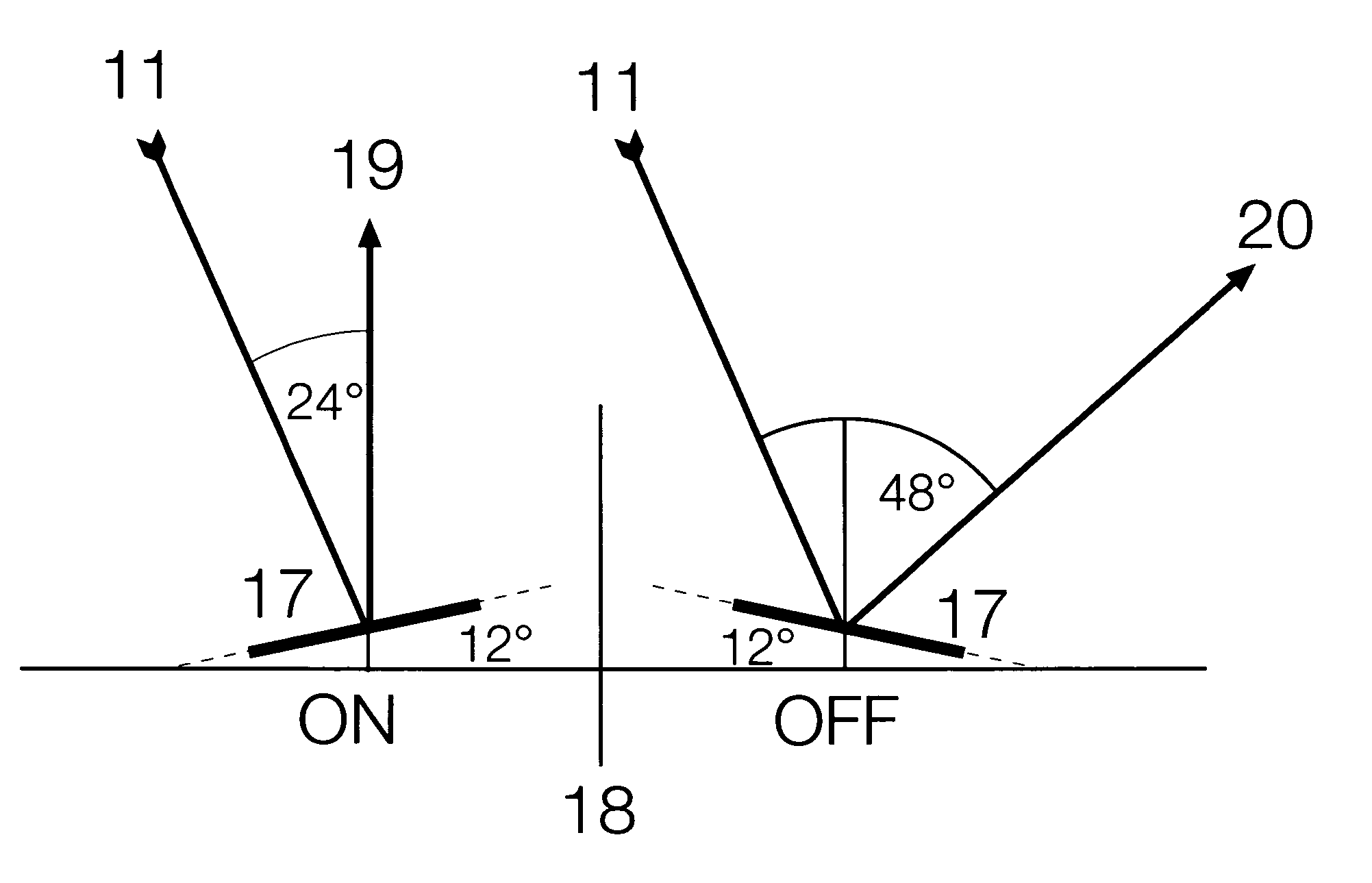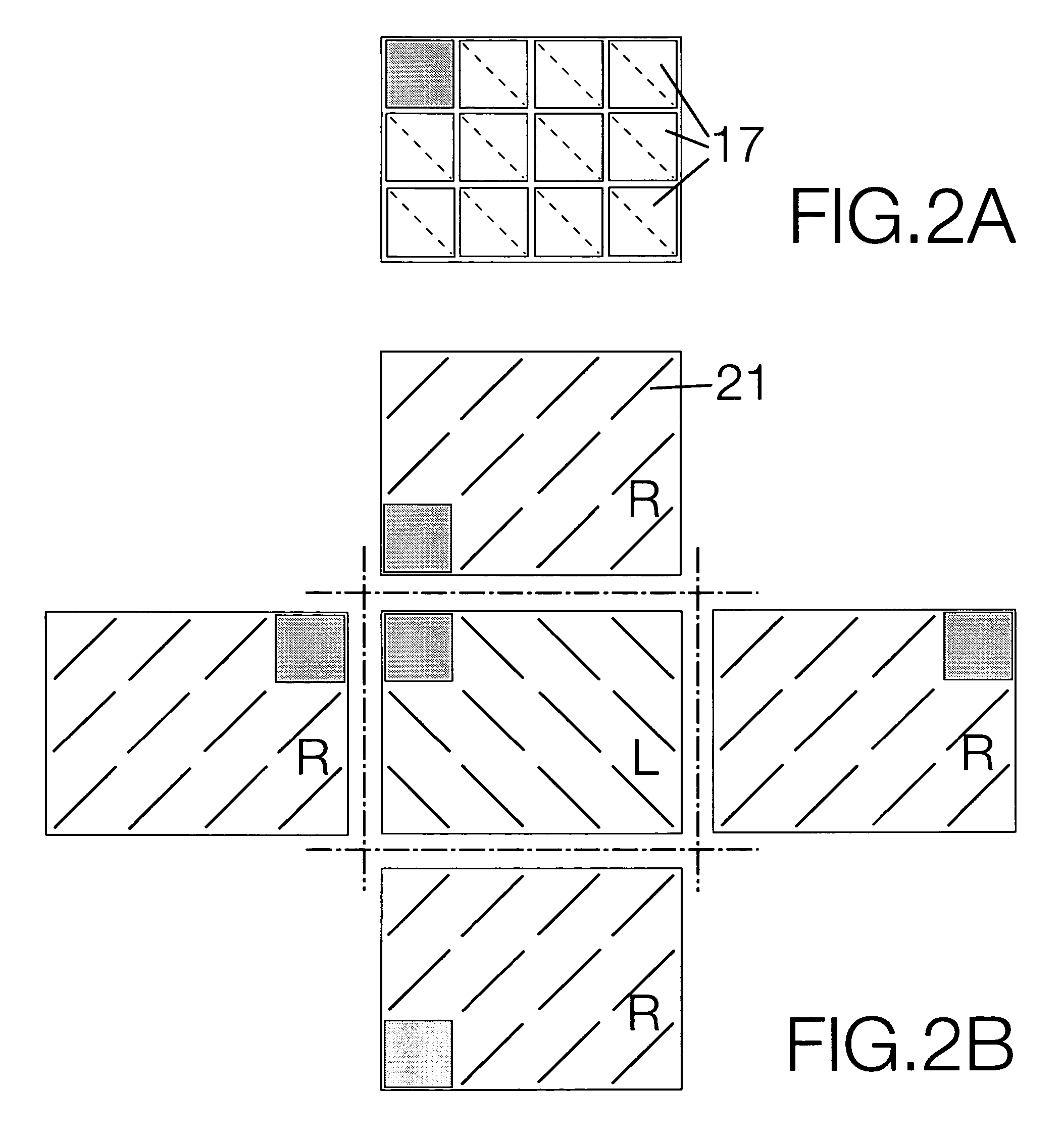2-Channel display system comprising micro electro mechanical systems
a technology of micro electromechanical systems and display systems, applied in optics, instruments, electrical equipment, etc., can solve the problems of not showing symmetry axes and no symmetrical light paths
- Summary
- Abstract
- Description
- Claims
- Application Information
AI Technical Summary
Benefits of technology
Problems solved by technology
Method used
Image
Examples
first embodiment
[0031]FIG. 4 shows the invention (stereo wings). Light beams emitted by a light source are directed to a first beam splitter (5) which splits the incident light (11) into two spatially separated and linearly polarized beams (“S” and “P” polarization states are indicated by stippled and dashed lines), resulting in two simultaneously modulated channels. It is appreciated that while the drawing shows a perpendicular angle between the channels resulting from the use of a MacNeille type PBS, other angles between the channels are possible if other types of beam splitters and incidence angles are used for beam splitting and / or beam combining (e.g. wire grid polarizers WGP). Both polarized beams are then directed onto two spatial light modulators (1 and 2, SLMs, e.g. DMDs) in two functionally identical modules, which are arranged mirror symmetrically, and which comprise a total internal reflection prism (TIR) each (3) resp. (4). The said SLMs, shown are DMDs, modulate the incident beam (11)...
second embodiment
[0032]FIG. 5 shows the invention, which is derived by the folding of the wings in Fig. A (folded stereo wings). Both TIRs are rotated by 90°, the folding is accomplished by two deflection mirrors (8), which connect the output of the polarization splitter (5) to the rotated TIRs. The light path in the two channels is directed such that TPOI is now perpendicular to PPOI. The arrangement shown in FIG. 5 may be advantageous when a back focal length (optical length between modulators and projection lens) of minimum size is required. FIG. 5 shows this embodiment of the invention in a top view (FIG. 5B), three side views (FIG. 5A, C, D) and an isometric scheme (FIG. 5E). Beams in the uppermost layers of the views are shown in solid lines, while a dashed line indicates beams in lower planes. Optical axes perpendicular to the drawing plane (paper plane) are indicated by a small circle. In FIG. 5E, the input splitter PBS (5) in the top of the arrangement, the combiner PBS (6) at the bottom of...
fourth embodiment
[0034]FIG. 7 is the invention (folded stereo wings with simultaneous color generation). As in the first three embodiments, preferentially both stereo isometric forms of the MEMSs are used. It is a slightly enhanced setup compared to FIG. 5, where instead of the single MEMSs (1) and (2) a color separation / color recombination system (23, 24) is connected to the TIRs (3) and (A). These systems in the drawing comprise TPAs with 3 MEMS each for each primary color in both channels (13) and (14). It is well appreciated that other systems for simultaneous color generation could replace the TPAs within the scope of our invention. The drawing also indicates two optional polarization correction systems (9) and (10) for the “S” and the “P”-channels. Please note that the 45° rotated position of the TPA in one channel, which is state of the art (e.g.Texas Instruments Technical Journal, 1998: Larry J. Hornbeck: From cathode rays to digital micro mirrors: A history of electronic projection display ...
PUM
 Login to View More
Login to View More Abstract
Description
Claims
Application Information
 Login to View More
Login to View More - R&D
- Intellectual Property
- Life Sciences
- Materials
- Tech Scout
- Unparalleled Data Quality
- Higher Quality Content
- 60% Fewer Hallucinations
Browse by: Latest US Patents, China's latest patents, Technical Efficacy Thesaurus, Application Domain, Technology Topic, Popular Technical Reports.
© 2025 PatSnap. All rights reserved.Legal|Privacy policy|Modern Slavery Act Transparency Statement|Sitemap|About US| Contact US: help@patsnap.com



